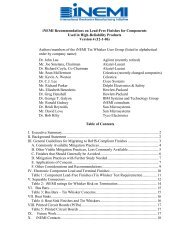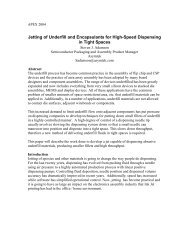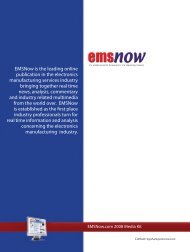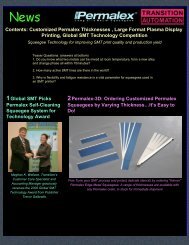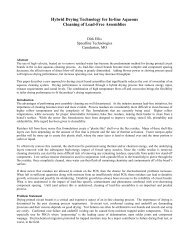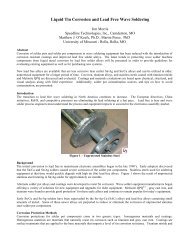The effects of Pb-free solder paste formulation on voiding ... - EMSNow
The effects of Pb-free solder paste formulation on voiding ... - EMSNow
The effects of Pb-free solder paste formulation on voiding ... - EMSNow
You also want an ePaper? Increase the reach of your titles
YUMPU automatically turns print PDFs into web optimized ePapers that Google loves.
<str<strong>on</strong>g>The</str<strong>on</strong>g> <str<strong>on</strong>g>effects</str<strong>on</strong>g> <str<strong>on</strong>g>of</str<strong>on</strong>g> <str<strong>on</strong>g>Pb</str<strong>on</strong>g>-<str<strong>on</strong>g>free</str<strong>on</strong>g> <str<strong>on</strong>g>solder</str<strong>on</strong>g> <str<strong>on</strong>g>paste</str<strong>on</strong>g> <str<strong>on</strong>g>formulati<strong>on</strong></str<strong>on</strong>g> <strong>on</strong> <strong>voiding</strong> in reflowed assemblies<br />
Brian Toleno PhD, Applicati<strong>on</strong> Engineering Team Leader, <str<strong>on</strong>g>The</str<strong>on</strong>g> Electr<strong>on</strong>ics Group <str<strong>on</strong>g>of</str<strong>on</strong>g> Henkel, Irvine, CA<br />
It’s generally accepted that voids in <str<strong>on</strong>g>solder</str<strong>on</strong>g> joints are more comm<strong>on</strong> in <str<strong>on</strong>g>Pb</str<strong>on</strong>g>-<str<strong>on</strong>g>free</str<strong>on</strong>g> assemblies. While a very low<br />
amount <str<strong>on</strong>g>of</str<strong>on</strong>g> <strong>voiding</strong> may have little detrimental effect, a limit <strong>on</strong> the acceptable level <str<strong>on</strong>g>of</str<strong>on</strong>g> voids has never been<br />
established, thus the safest course <str<strong>on</strong>g>of</str<strong>on</strong>g> acti<strong>on</strong> is to strive for their eliminati<strong>on</strong>.<br />
To do this, <strong>on</strong>e must first c<strong>on</strong>sider the factors that influence void formati<strong>on</strong>. Compared to Sn-<str<strong>on</strong>g>Pb</str<strong>on</strong>g> <str<strong>on</strong>g>solder</str<strong>on</strong>g>s, <str<strong>on</strong>g>Pb</str<strong>on</strong>g><str<strong>on</strong>g>free</str<strong>on</strong>g><br />
<str<strong>on</strong>g>solder</str<strong>on</strong>g> alloys exhibit higher alloy surface tensi<strong>on</strong>, reduced speed <str<strong>on</strong>g>of</str<strong>on</strong>g> wetting, and higher alloy<br />
solidificati<strong>on</strong> temperatures, requiring corresp<strong>on</strong>dingly higher reflow temperatures. When a <str<strong>on</strong>g>Pb</str<strong>on</strong>g>-<str<strong>on</strong>g>free</str<strong>on</strong>g> alloy<br />
powder is blended with other chemical comp<strong>on</strong>ents to form <str<strong>on</strong>g>solder</str<strong>on</strong>g> <str<strong>on</strong>g>paste</str<strong>on</strong>g>, additi<strong>on</strong>al variables are introduced<br />
that may also have an effect <strong>on</strong> void formati<strong>on</strong>. To judge the influence that <str<strong>on</strong>g>solder</str<strong>on</strong>g> <str<strong>on</strong>g>paste</str<strong>on</strong>g> <str<strong>on</strong>g>formulati<strong>on</strong></str<strong>on</strong>g> has <strong>on</strong><br />
<strong>voiding</strong>, factors to be c<strong>on</strong>sidered are <str<strong>on</strong>g>solder</str<strong>on</strong>g> <str<strong>on</strong>g>paste</str<strong>on</strong>g> flux c<strong>on</strong>tent, the solvent c<strong>on</strong>centrati<strong>on</strong> in the flux, the<br />
boiling temperature <str<strong>on</strong>g>of</str<strong>on</strong>g> the solvent in the flux and the activator c<strong>on</strong>centrati<strong>on</strong> in the flux. It is wise to also<br />
c<strong>on</strong>sider <strong>on</strong>e <str<strong>on</strong>g>of</str<strong>on</strong>g> the process factors that is subject to c<strong>on</strong>siderable variati<strong>on</strong> – the shape <str<strong>on</strong>g>of</str<strong>on</strong>g> the reflow pr<str<strong>on</strong>g>of</str<strong>on</strong>g>ile.<br />
Experimental outline<br />
To determine the <str<strong>on</strong>g>effects</str<strong>on</strong>g> <str<strong>on</strong>g>of</str<strong>on</strong>g> these factors <strong>on</strong> a commercial <str<strong>on</strong>g>Pb</str<strong>on</strong>g>-<str<strong>on</strong>g>free</str<strong>on</strong>g> <str<strong>on</strong>g>solder</str<strong>on</strong>g> <str<strong>on</strong>g>paste</str<strong>on</strong>g>, it was decided to produce a<br />
series <str<strong>on</strong>g>of</str<strong>on</strong>g> <str<strong>on</strong>g>Pb</str<strong>on</strong>g>-<str<strong>on</strong>g>free</str<strong>on</strong>g> <str<strong>on</strong>g>solder</str<strong>on</strong>g> <str<strong>on</strong>g>paste</str<strong>on</strong>g>s having various flux/solvent/activator <str<strong>on</strong>g>formulati<strong>on</strong></str<strong>on</strong>g>s and reflow them with Sn-<str<strong>on</strong>g>Pb</str<strong>on</strong>g><br />
comp<strong>on</strong>ents, using two different reflow pr<str<strong>on</strong>g>of</str<strong>on</strong>g>iles. To ensure a suitably scientific study, an experiment<br />
incorporating these <str<strong>on</strong>g>formulati<strong>on</strong></str<strong>on</strong>g> and process variables was planned using design <str<strong>on</strong>g>of</str<strong>on</strong>g> experiment (DOE)<br />
techniques to devise 28 procedures based <strong>on</strong> the following:<br />
o Primary materials factors: flux c<strong>on</strong>centrati<strong>on</strong>, solvent c<strong>on</strong>centrati<strong>on</strong>, solvent boiling temperature and<br />
activator c<strong>on</strong>centrati<strong>on</strong>.<br />
o Sec<strong>on</strong>dary materials factors: viscosity, hot slump, flux volatile c<strong>on</strong>tent and rate <str<strong>on</strong>g>of</str<strong>on</strong>g> flux volatilisati<strong>on</strong> at<br />
alloy solidificati<strong>on</strong>.<br />
o Resp<strong>on</strong>ses: number <str<strong>on</strong>g>of</str<strong>on</strong>g> joints with voids, percentage area <str<strong>on</strong>g>of</str<strong>on</strong>g> <strong>voiding</strong>, and size distributi<strong>on</strong> <str<strong>on</strong>g>of</str<strong>on</strong>g> voids.<br />
To carry out each experiment, SAC387 <str<strong>on</strong>g>Pb</str<strong>on</strong>g>-<str<strong>on</strong>g>free</str<strong>on</strong>g> <str<strong>on</strong>g>solder</str<strong>on</strong>g> <str<strong>on</strong>g>paste</str<strong>on</strong>g> was printed <strong>on</strong> copper pads at 0.5mm pitch,<br />
using a 0.12mm (5 mil) thickness stencil, and a BGA comp<strong>on</strong>ent with Sn-<str<strong>on</strong>g>Pb</str<strong>on</strong>g> balls was placed – this was the<br />
combinati<strong>on</strong> expected to give the highest rate <str<strong>on</strong>g>of</str<strong>on</strong>g> <strong>voiding</strong>. <str<strong>on</strong>g>The</str<strong>on</strong>g> reflow pr<str<strong>on</strong>g>of</str<strong>on</strong>g>iles employed were a linear pr<str<strong>on</strong>g>of</str<strong>on</strong>g>ile <str<strong>on</strong>g>of</str<strong>on</strong>g><br />
1 minute 48 sec<strong>on</strong>ds durati<strong>on</strong> and a soak pr<str<strong>on</strong>g>of</str<strong>on</strong>g>ile <str<strong>on</strong>g>of</str<strong>on</strong>g> 3 minutes 10 sec<strong>on</strong>ds, the soak occurring at around<br />
160°C. Both pr<str<strong>on</strong>g>of</str<strong>on</strong>g>iles peaked at 236°C. Similar experiments were carried out with SOICs for comparis<strong>on</strong>.<br />
Analysing the data<br />
With the experimental procedures completed, the gathered data were analysed to:<br />
o seek out <str<strong>on</strong>g>solder</str<strong>on</strong>g> <str<strong>on</strong>g>paste</str<strong>on</strong>g> properties that were affected by the primary parameters<br />
o look for correlati<strong>on</strong> between the physical properties <str<strong>on</strong>g>of</str<strong>on</strong>g> the <str<strong>on</strong>g>solder</str<strong>on</strong>g> <str<strong>on</strong>g>paste</str<strong>on</strong>g>s with the <strong>voiding</strong> resp<strong>on</strong>se<br />
o observe the influence <str<strong>on</strong>g>of</str<strong>on</strong>g> the primary parameters <strong>on</strong> the <strong>voiding</strong> resp<strong>on</strong>ses.<br />
Using an x-ray system <str<strong>on</strong>g>of</str<strong>on</strong>g>fering feature recogniti<strong>on</strong> down to 1µm, it was possible to count the number <str<strong>on</strong>g>of</str<strong>on</strong>g> BGA<br />
balls showing voids, the number <str<strong>on</strong>g>of</str<strong>on</strong>g> voids and to measure their projected area. Similarly, for SOIC joints, the<br />
number <str<strong>on</strong>g>of</str<strong>on</strong>g> joints with voids and the number <str<strong>on</strong>g>of</str<strong>on</strong>g> voids were counted.
Half-normal probability charts were plotted to determine the parameters that had the greatest effect <strong>on</strong> <str<strong>on</strong>g>paste</str<strong>on</strong>g><br />
viscosity, hot slump, BGA <strong>voiding</strong> and SOIC <strong>voiding</strong>.<br />
Results – Parameters having the greatest effect <strong>on</strong> <str<strong>on</strong>g>paste</str<strong>on</strong>g> properties (in descending order)<br />
Viscosity:<br />
1. Solvent c<strong>on</strong>centrati<strong>on</strong> in the flux<br />
2. Solvent choice<br />
Hot slump:<br />
1. Solvent choice<br />
2. Activator c<strong>on</strong>centrati<strong>on</strong> in the flux<br />
Voiding – for BGAs:<br />
1. Reflow pr<str<strong>on</strong>g>of</str<strong>on</strong>g>ile al<strong>on</strong>e<br />
2. Choice and quantity <str<strong>on</strong>g>of</str<strong>on</strong>g> solvent and activator<br />
3. Quantity <str<strong>on</strong>g>of</str<strong>on</strong>g> flux, plus choice and quantity <str<strong>on</strong>g>of</str<strong>on</strong>g> solvent<br />
4. Choice <str<strong>on</strong>g>of</str<strong>on</strong>g> solvent, plus activator level, plus reflow pr<str<strong>on</strong>g>of</str<strong>on</strong>g>ile<br />
Voiding – for SOICs:<br />
1. Solvent choice<br />
2. Flux quantity in <str<strong>on</strong>g>solder</str<strong>on</strong>g> <str<strong>on</strong>g>paste</str<strong>on</strong>g><br />
3. Solvent quantity in flux<br />
4. Quantity <str<strong>on</strong>g>of</str<strong>on</strong>g> solvent in flux and <str<strong>on</strong>g>solder</str<strong>on</strong>g> <str<strong>on</strong>g>paste</str<strong>on</strong>g>, plus reflow pr<str<strong>on</strong>g>of</str<strong>on</strong>g>ile<br />
<str<strong>on</strong>g>The</str<strong>on</strong>g> worst case for voids in the study occurred when <str<strong>on</strong>g>solder</str<strong>on</strong>g>ing BGAs with a highly volatile flux and a linear<br />
pr<str<strong>on</strong>g>of</str<strong>on</strong>g>ile.<br />
Results – Parameters having the greatest effect <strong>on</strong> volatilisati<strong>on</strong> (in descending order)<br />
Flux weight loss:<br />
1. C<strong>on</strong>centrati<strong>on</strong> <str<strong>on</strong>g>of</str<strong>on</strong>g> solvent in the flux<br />
2. C<strong>on</strong>centrati<strong>on</strong> <str<strong>on</strong>g>of</str<strong>on</strong>g> activator in the flux<br />
Rate <str<strong>on</strong>g>of</str<strong>on</strong>g> flux weight loss:<br />
1. Solvent type<br />
2. Reflow pr<str<strong>on</strong>g>of</str<strong>on</strong>g>ile<br />
<str<strong>on</strong>g>The</str<strong>on</strong>g>se results hold true for both the linear and the soak pr<str<strong>on</strong>g>of</str<strong>on</strong>g>ile; comparing the percentage weight loss and<br />
the rate <str<strong>on</strong>g>of</str<strong>on</strong>g> weight loss at the alloy <str<strong>on</strong>g>free</str<strong>on</strong>g>zing temperature, there was no c<strong>on</strong>sistent difference between the<br />
pr<str<strong>on</strong>g>of</str<strong>on</strong>g>iles.<br />
It was noted that the average number <str<strong>on</strong>g>of</str<strong>on</strong>g> voids increased with increasing rate <str<strong>on</strong>g>of</str<strong>on</strong>g> volatilisati<strong>on</strong> for both BGAs<br />
and SOICs, although the <strong>voiding</strong> resp<strong>on</strong>se to flux volatility was much more pr<strong>on</strong>ounced for the latter type <str<strong>on</strong>g>of</str<strong>on</strong>g><br />
comp<strong>on</strong>ent.<br />
Interpretati<strong>on</strong> <str<strong>on</strong>g>of</str<strong>on</strong>g> results<br />
From this experimental work, the main factors c<strong>on</strong>trolling void formati<strong>on</strong> appear to be reflow pr<str<strong>on</strong>g>of</str<strong>on</strong>g>ile and flux<br />
volatility. Although altering the flux <str<strong>on</strong>g>formulati<strong>on</strong></str<strong>on</strong>g> affects other physical properties <str<strong>on</strong>g>of</str<strong>on</strong>g> the <str<strong>on</strong>g>solder</str<strong>on</strong>g> <str<strong>on</strong>g>paste</str<strong>on</strong>g>, these do<br />
not seem to be str<strong>on</strong>gly related to <strong>voiding</strong>. Void formati<strong>on</strong> in BGA and SOIC joints seem to be c<strong>on</strong>trolled by<br />
different mechanisms, the rate <str<strong>on</strong>g>of</str<strong>on</strong>g> flux volatilisati<strong>on</strong> as the alloy <str<strong>on</strong>g>free</str<strong>on</strong>g>zes having a greater effect <strong>on</strong> <strong>voiding</strong><br />
around SOIC joints.
In search <str<strong>on</strong>g>of</str<strong>on</strong>g> a <strong>voiding</strong>-resistant <str<strong>on</strong>g>solder</str<strong>on</strong>g> <str<strong>on</strong>g>paste</str<strong>on</strong>g> <str<strong>on</strong>g>formulati<strong>on</strong></str<strong>on</strong>g><br />
With this informati<strong>on</strong> in hand, a low-<strong>voiding</strong> <str<strong>on</strong>g>solder</str<strong>on</strong>g> <str<strong>on</strong>g>paste</str<strong>on</strong>g> <str<strong>on</strong>g>formulati<strong>on</strong></str<strong>on</strong>g> was devised and trialled <strong>on</strong> the<br />
producti<strong>on</strong> line <str<strong>on</strong>g>of</str<strong>on</strong>g> a c<strong>on</strong>tract manufacturer in China. <str<strong>on</strong>g>The</str<strong>on</strong>g> SAC387-based <str<strong>on</strong>g>solder</str<strong>on</strong>g> <str<strong>on</strong>g>paste</str<strong>on</strong>g> was used to <str<strong>on</strong>g>solder</str<strong>on</strong>g><br />
both lead-<str<strong>on</strong>g>free</str<strong>on</strong>g> and Sn-<str<strong>on</strong>g>Pb</str<strong>on</strong>g> PBGA 256 comp<strong>on</strong>ents; the <str<strong>on</strong>g>Pb</str<strong>on</strong>g>-<str<strong>on</strong>g>free</str<strong>on</strong>g> type was bumped with SAC405 and the other<br />
with Sn63.<br />
Eight different pr<str<strong>on</strong>g>of</str<strong>on</strong>g>iles were run for the <str<strong>on</strong>g>Pb</str<strong>on</strong>g>-<str<strong>on</strong>g>free</str<strong>on</strong>g>, and four for the Sn-<str<strong>on</strong>g>Pb</str<strong>on</strong>g>, and the results compared to those<br />
achieved with other commercially available <str<strong>on</strong>g>solder</str<strong>on</strong>g> <str<strong>on</strong>g>paste</str<strong>on</strong>g>s. Two distinct differences were noted between the<br />
pr<str<strong>on</strong>g>of</str<strong>on</strong>g>iles that gave good results and those that gave the worst results: extended preheat times and reduced<br />
time above liquidus were preferable (see Table 1).<br />
Table 1: Effect <str<strong>on</strong>g>of</str<strong>on</strong>g> pr<str<strong>on</strong>g>of</str<strong>on</strong>g>ile <strong>on</strong> <strong>voiding</strong> results<br />
Setting Pr<str<strong>on</strong>g>of</str<strong>on</strong>g>ile 1 Pr<str<strong>on</strong>g>of</str<strong>on</strong>g>ile 2 Pr<str<strong>on</strong>g>of</str<strong>on</strong>g>ile 3 Pr<str<strong>on</strong>g>of</str<strong>on</strong>g>ile 4<br />
Preheat time 130-165°C, s 101 80 107 35<br />
Time to peak, s 261 333 260 289<br />
Ramp time 165-217°C, s 39 100 32 72<br />
Time above liquidus, s 33 68 44 96<br />
Voiding result ✔ ✔ ✔ ✘<br />
C<strong>on</strong>clusi<strong>on</strong>s<br />
Studies are still <strong>on</strong>going, but it is apparent that a better understanding <str<strong>on</strong>g>of</str<strong>on</strong>g> the <str<strong>on</strong>g>solder</str<strong>on</strong>g> <str<strong>on</strong>g>paste</str<strong>on</strong>g> factors that<br />
influence <strong>voiding</strong> can c<strong>on</strong>tribute to the design <str<strong>on</strong>g>of</str<strong>on</strong>g> a <str<strong>on</strong>g>solder</str<strong>on</strong>g> <str<strong>on</strong>g>paste</str<strong>on</strong>g> that reduces the incidence <str<strong>on</strong>g>of</str<strong>on</strong>g> this defect. Also<br />
worth bearing in mind is the effect <str<strong>on</strong>g>of</str<strong>on</strong>g> the reflow pr<str<strong>on</strong>g>of</str<strong>on</strong>g>ile – paying close attenti<strong>on</strong> to preheat time and time<br />
above liquidus can reduce <strong>voiding</strong>.



